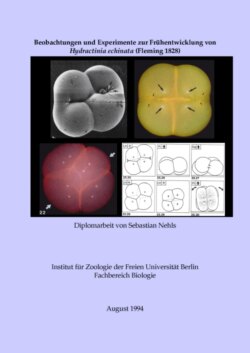Читать книгу Beobachtungen und Experimente zur Frühentwicklung von Hydractinia echinata (Fleming 1828) - Sebastian Nehls - Страница 6
На сайте Литреса книга снята с продажи.
Abstract (English)
ОглавлениеThis Book contains a "Diplom" thesis (for Graduation at a German University) from the year 1994 in biology. It contains seven drawings, eight electron microscopical photos (b/w), one transmitted light microscopical photo, and 21 fluorescence microscopical colour photographs.
The work describes and investigates the early development and cell divisions of the marine polyp Hydractinia echinata (Flem.) (Cnidaria, Hydrozoa) up to the 16-cell-stage. Examinations were made by light- and fluorescence microscpy as well as transmission- and scanning electron microscopy. Fluorescent labeling with anti-tubulin and DAPI could show extension and position of the mitotic apparatus as well as the states of the nuclei in the cell cycle. Rhodaminyl phalloidin was used to visualize F-actin.
In most of the cases, the first two cleavage furrowings are meridional with orthogonal planes, the third cleavage is equatorial. Nevertheless, there exists some variability in the positioning of the mitotic planes.
By labeling with an external vital stain, combined with time-lapse video-microscopy, it could be seen that the Hydractinia embryo carries out a 90 degree turn just before the second cleavage. During this, the animal-vegetative axis tilts from its ground-parallel orientation into an orthogonal one. In most of the cases, the animal pole ends up being on top. At the start of the first and third cleavage, similar movements of the embryo occur.
The turns of the Hydractinia embryo are caused by changes in shape.
The maximum extension of the asters before the beginning of furrowing in telophase and the positioning of the mitotic apparatus correlate with the embryo's changes in shape and are probably the cause of these changes.
Experiments with nocodazole, a known inhibitor of microtubuli formation, showed that a) without microtubuli, initiation of furrowing was inhibited, b) the progression of furrowing was disturbed, resulting in total blockage, if the furrow had not already progressed over more than the half of the respective cells.
Experiments with the F-Actin-affecting inhibitor cytochalasin B (0,05 - 2,5 µg/ml) showed that a) cytokinesis was not blocked, b) adhesion of the blastomeres to each other was often dissolved and c) toxic effects (cell blebbing and malformation) could occur.
Staining with rhodaminyl phalloidin to show F-Actin and subsequent fluorescence microscopical examination could not produce any evidence for a "contractile ring" or "arch" located beneath the furrow.
